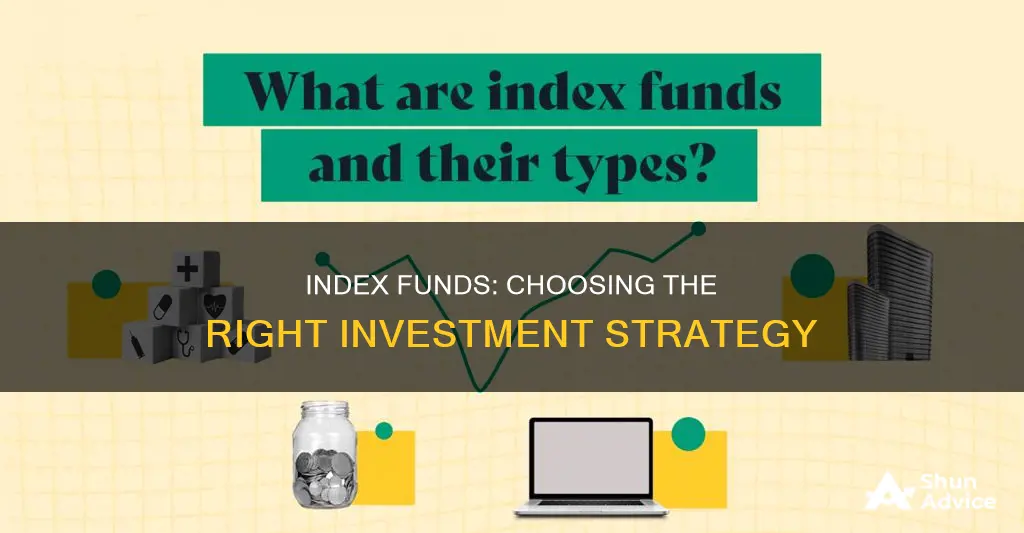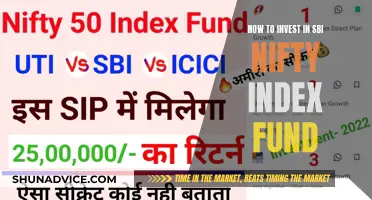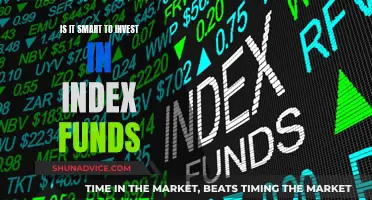
Index funds are a popular investment choice for those seeking low-cost, diversified, and passive investments that often outperform higher-fee, actively traded funds. They are designed to replicate the performance of financial market indexes, like the S&P 500, and are ideal for long-term investing, such as retirement accounts.
Index funds are a type of mutual or exchange-traded fund (ETF) that tracks the performance of a market index by holding the same stocks, bonds, or a representative sample of them. They are passively managed, meaning they aim to mirror the performance of a designated index without active management. This passive management strategy results in lower fees, making them an attractive option for investors.
When choosing an index fund to invest in, it is important to consider factors such as the fund's expenses, taxes, and investment minimums. Additionally, investors should decide whether they want to invest in a mutual fund or an ETF, as there are advantages and disadvantages to each.
By investing in index funds, individuals can benefit from broad market exposure, diversification, and long-term solid returns. However, it is important to remember that index funds are subject to market swings and lack the flexibility of active management.
| Characteristics | Values |
|---|---|
| Type | Mutual fund or exchange-traded fund (ETF) |
| Investment strategy | Passive |
| Investment aim | To mirror the performance of a designated market index |
| Management | Fund managers aim to replicate the index without active management |
| Investment options | Stocks, bonds, commodities, cash, large/mid/small-cap companies, international stocks, sector-specific stocks |
| Costs | Low fees, low expense ratio, low transaction costs |
| Returns | Historically, index funds have outperformed actively managed funds over the long term |
| Risk | Lower risk due to diversification, but vulnerable to market downturns |
| Suitability | Good for beginners, long-term investors, retirement investors |
What You'll Learn

Mutual funds vs. ETFs
Both mutual funds and ETFs (exchange-traded funds) are popular investment vehicles that offer diversification and exposure to a wide variety of asset classes and niche markets. They are similar in that they both represent professionally managed collections or "baskets" of individual stocks or bonds. However, there are some key differences between the two that investors should be aware of when deciding which type of fund to invest in.
One of the main differences between mutual funds and ETFs lies in how they are traded. Mutual funds are typically bought and sold at the end of each trading day, based on a calculated price known as the net asset value (NAV). In contrast, ETFs trade like stocks on an exchange and can be bought and sold throughout the trading day, just like ordinary stocks. This gives investors more control over the price of their trades and makes ETFs a better choice for active traders.
Another difference is in the investment minimums required. Mutual funds usually have higher minimum investment requirements, often in the hundreds or thousands of dollars. ETFs, on the other hand, can be purchased for the price of a single share, which can be as little as $50 or a few hundred dollars. This makes ETFs more suitable for investors who want lower investment minimums.
Additionally, mutual funds are usually actively managed, meaning fund managers make decisions about how to allocate assets to try and beat the market. ETFs, on the other hand, are usually passively managed, meaning they track a market index or sector sub-index. This passive management strategy results in lower fees and expense ratios for ETFs compared to mutual funds.
The choice between mutual funds and ETFs depends on your investment goals, risk tolerance, and investment style. If you prefer lower investment minimums, more hands-on control over the price of your trades, and passive investments, then ETFs may be more suitable for you. On the other hand, if you want to make regular deposits, repeat specific transactions automatically, or have a chance to beat the market, then mutual funds could be a better option. It's important to consider your personal circumstances and seek professional advice before making any investment decisions.
T. Rowe Price Funds: Cruise Investment Options Explored
You may want to see also

Low fees
Index funds are a great investment option for those seeking low-cost, diversified, and passive investments that tend to outperform many higher-fee, actively traded funds.
Index funds are a type of mutual or exchange-traded fund (ETF) that tracks the performance of a market index, such as the S&P 500, by holding the same stocks or bonds or a representative sample of them. They are passively managed, meaning they aim to replicate the performance of a designated index without active management. This passive management strategy results in lower fees, which is one of the biggest selling points of index funds.
When choosing an index fund to invest in, it is important to consider the fund's expenses as they could cost you tens of thousands of dollars over time. Compare the expense ratios of different funds that track the same index and opt for the one with the lowest ratio. For example, the Vanguard S&P 500 ETF has an expense ratio of 0.03%, while the SPDR S&P 500 ETF Trust's expense ratio is 0.095%.
Additionally, consider the trading costs associated with the fund. Some brokers offer very attractive prices when buying mutual funds, and most major online brokers now allow ETF trading without a commission. It is also important to note that mutual funds tend to be less tax-efficient than ETFs as they often pay taxable capital gains distributions at the end of the year.
- Fidelity ZERO Large Cap Index: This mutual fund offered by Fidelity has an expense ratio of 0%, meaning there are no fees for investors.
- Vanguard S&P 500 ETF: With an expense ratio of 0.03%, this ETF offered by Vanguard is one of the largest funds on the market.
- IShares Core S&P 500 ETF: This ETF, sponsored by BlackRock, has an expense ratio of 0.03%.
- Schwab S&P 500 Index Fund: With an expense ratio of 0.02%, this mutual fund offered by Charles Schwab is known for its investor-friendly focus.
- Vanguard Total Stock Market ETF: Another Vanguard fund with an expense ratio of 0.03%, this ETF covers the entire universe of publicly traded stocks in the US.
By choosing index funds with low fees, you can maximize your investment returns over time.
Maximizing Your Roth IRA: Alternative Investment Options
You may want to see also

Passive vs. active management
Index funds are a type of investment fund that can be either a mutual fund or an exchange-traded fund (ETF). They are designed to track a specific market index, such as the S&P 500, and aim to replicate its performance. There are two main approaches to managing index funds: passive management and active management. So, what's the difference between these two strategies?
Passive Portfolio Management
Passive portfolio management, also known as index fund management, involves creating a portfolio that mimics a particular market index. Instead of actively selecting stocks, passive managers aim to replicate the holdings of the chosen index as closely as possible. This means that if the S&P 500 index includes 500 large US companies, a passive fund manager will include all those companies in the fund's portfolio, weighting them in the same way as the index. The goal of passive management is to generate returns that match the chosen index, hence the term "passive".
Passive management is often associated with lower fees because it does not require a team of analysts or portfolio managers to actively select and time trades. Instead, the fund simply buys and holds the same investments as the index it tracks. This makes passive funds a popular choice for investors who want a more hands-off approach and are willing to accept market-level returns.
Active Portfolio Management
Active portfolio management, on the other hand, involves trying to outperform the market or a specific benchmark index. Active fund managers will frequently buy and sell investments based on their research and market forecasts, aiming to generate higher returns than the market average. This approach typically requires a team of analysts and portfolio managers who study market trends, economic shifts, political changes, and other factors that may impact specific companies or sectors. Active management is generally more expensive due to the higher level of expertise and resources required.
Active management can be appealing to investors who believe that skilled fund managers can consistently beat the market. It offers more flexibility in terms of investment choices and allows for hedging and risk management strategies. However, it's important to note that despite their best efforts, active managers rarely outperform the market over the long term.
The debate between passive and active management has been ongoing, with supporters of each approach highlighting their respective strengths. Passive investing is often praised for its low fees, transparency, and tax efficiency. On the other hand, active investing offers the potential for higher returns, flexibility, and the ability to actively manage risk.
Ultimately, the decision to choose between passive and active management depends on an investor's goals, risk tolerance, and investment horizon. Many investors and advisors advocate for a blended approach, utilising both strategies to take advantage of their unique benefits and minimise potential drawbacks.
Private Equity Funds: Impact Investing Strategies Revealed
You may want to see also

Tax efficiency
Taxes can be one of the biggest expenses on investments. Therefore, it is important to consider tax efficiency when deciding which index fund to invest in.
Taxable vs. Tax-Advantaged Accounts
Firstly, it is important to understand the difference between taxable and tax-advantaged accounts. Taxable accounts, such as brokerage accounts, offer more flexibility than tax-advantaged accounts. The returns are taxed depending on how long the asset was held. Investments held for longer than a year are taxed at a lower rate than those held for a year or less.
On the other hand, tax-advantaged accounts like IRAs and 401(k)s provide tax breaks. With tax-deferred accounts, investors pay taxes when they withdraw their money in retirement, whereas with tax-exempt accounts, contributions are made with after-tax dollars, but investments grow tax-free.
Tax-Efficient Investments
When it comes to choosing tax-efficient investments, municipal bonds are a good option as they are exempt from federal income tax and may also be exempt from state and local taxes. Treasury bonds and Series I bonds are also tax-efficient as they are exempt from state and local income taxes. Exchange-traded funds (ETFs) are also a good option as they are passively managed and have a low turnover, resulting in fewer capital gains distributions.
Tax-Efficient Strategies
There are several tax-efficient strategies that can be employed. One strategy is tax-loss harvesting, which involves selling investments at a loss to offset taxable gains from profitable investments. Another strategy is to hold investments for the long term, as long-term capital gains are taxed at a lower rate than short-term gains. Additionally, donating investments to charity may help mitigate capital gains taxes.
Tax-Efficient Asset Location
Choosing the right location for your investments can also help minimize taxes. For example, placing assets that are likely to result in a large tax bill in a tax-advantaged account, and those that are less likely to generate a large tax bill in a non-tax-advantaged account.
Tax-Efficient Funds
When it comes to tax-efficient funds, index funds and ETFs are a good choice as they are passively managed and have low turnover, resulting in fewer capital gains distributions. Tax-managed funds are also designed to minimize taxes by holding stocks for more than a year and practising tax-loss harvesting.
Mutual Fund Investment Strategies: Where to Invest?
You may want to see also

Long-term performance
Index funds are a great investment for long-term performance. They are a low-cost, easy way to build wealth, and they often perform better than actively managed funds over time.
Index funds are a type of investment fund that tracks the performance of a market index, such as the S&P 500. They are designed to mirror the performance of the index, so if the index goes up, the fund goes up, and if the index goes down, the fund goes down. This means that index funds are a passive investment strategy, as there is no active management involved.
- Low costs: Index funds typically have lower expense ratios than actively managed funds because they are passively managed. This means that you can save money on fees and other costs associated with active management.
- Diversification: Index funds provide broad market exposure and diversification across various sectors and asset classes. This helps to reduce risk, as your investment is not tied to the performance of a single company or industry.
- Historical performance: Over the long term, index funds have often outperformed actively managed funds, especially after accounting for fees and expenses. The S&P 500, for example, has averaged an annual return of about 10% over the past several decades.
- Tax efficiency: Index funds tend to be more tax-efficient than actively managed funds because they typically have lower turnover rates, resulting in fewer capital gains distributions.
- Simplicity: Index funds are a simple and straightforward investment strategy. You don't need to be an expert in the stock market or spend a lot of time researching individual stocks.
- Long-term focus: Index funds are typically considered a long-term investment strategy. While the value of your investment may fluctuate in the short term, the goal is to hold onto your index funds for the long term to take advantage of the market's overall growth.
- Vanguard S&P 500 ETF (VOO)
- Schwab S&P 500 Index Fund (SWPPX)
- Vanguard Russell 2000 ETF (VTWO)
- Vanguard Total Stock Market ETF (VTI)
- SPDR Dow Jones Industrial Average ETF Trust (DIA)
- Fidelity ZERO Large Cap Index Fund (FNILX)
- Vanguard Growth ETF (VUG)
- Vanguard Real Estate ETF (VNQ)
- ROBO Global Robotics and Automation Index ETF
- Schwab Emerging Markets Equity ETF (SCHE)
Dimensional Fund Investing: What Products Are Offered?
You may want to see also
Frequently asked questions
An index fund is a type of mutual fund or exchange-traded fund (ETF) that tracks the performance of a market index, such as the S&P 500. Index funds are designed to mirror the performance of the index they track, and they are usually passively managed, meaning the fund manager does not actively adjust the fund's allocations.
Index funds offer a simple, low-cost way to gain exposure to a diversified portfolio of stocks or bonds. They are passively managed, have low expense ratios, and often outperform actively managed funds over the long term. Index funds are also more tax-efficient than actively managed funds due to lower turnover rates.
One drawback of index funds is their lack of flexibility. They are designed to mirror a specific market index, so they will decline in value when the market does. Index funds also include all the securities in an index, which may include overvalued or weak companies.
When choosing an index fund, consider the asset class you want to invest in, such as equities, bonds, small cap, or large cap. You should also look for a fund with a low expense ratio and consider whether it uses market-cap weighting or equal weighting.
This depends on your investment goals and preferences. Mutual funds may have minimum investment requirements, while ETFs typically do not. ETFs offer more trading flexibility and are a good option for investors who want to invest a small amount of money.







